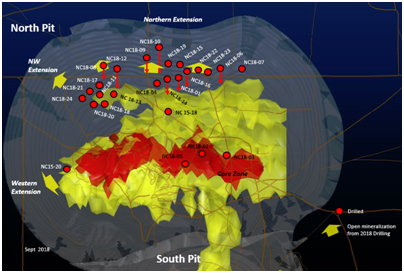Step Two on the Road to Mid-Tier
October 5, 2018
As you know, Nevada Copper is pursuing a three-step strategy towards mid-tier producer status – underground production, open pit production and regional development. With construction progress well underway, we are making excellent towards Step One (underground mine production). However, it’s important to note that, during this time, we are simultaneously advancing towards Step Two (open pit mine production).
Our most recent news release is part of that Step Two progress. Specifically, we have announced the results from the remaining nineteen summer program holes at Pumpkin Hollow, bringing the total to 26 holes.
The summer drilling focused on the expansion of mineralization and the upgrading of waste and inferred classified resources of our open pit asset. I’m delighted to say that every single hole hit mineralization and that, importantly, we accomplished some key goals.
Foremost amongst these goals is the waste-to-ore conversion program. We’ve mentioned several times in the past but for newcomers, I want to again point out that large areas in the region of the open pit development are/were classified as waste rock. For those of you who are new to the mining industry, let me explain this a little further because the term “waste rock” can be misleading.
In our 2015 Open Pit PFS technical report, certain areas in and around the open pit were termed waste rock regardless of how likely those areas were to host mineralization. This was due to the fact that we had not drilled those areas at all and could not in any way include them in our resource report.
Our belief is that a considerable amount of copper exists in the areas of waste rock that lie within and near the boundaries of the open pit walls and the summer drilling has provided us with ample proof that we are correct.
Following hot on the heels of the conversion program is the resource upgrade goal. Substantial areas of the pit deposits are classified as inferred simply as a result of wide? drill spacing. The opportunity we are pursuing here is to upgrade these areas to indicated (and above) category resources. This matters because when you publish pre-feasibility and feasibility reports your resources have to be classified as indicated or measured. We therefore anticipate the success of this part of the program potentially bearing fruit in the new resource that we will announce as part of our PFS work.
As the news release pointed out, both of our core goals are aimed at enhancing the scale and potential economics of the open pit project – both of which will be outlined in the updated PFS that is planned for Q1, 2019.
New zones of mineralization.
Putting the open pit development into production will turn us into a mid-tier producer. Yes, the open pit deposits are that large. However, it’s important to note that most of the project is either unexplored or underexplored. What that means is there is a lot the potential of exploration blue sky here and that’s an extremely good position to be in when you already have enough copper to become a mid-tier producer.

So, while we are delighted with our progress towards converting waste rock and upgrading the large areas of inferred areas of mineralization during the summer, we are also very pleased with the extension of high-grade mineralization into a new area.
The specifics are that three of our drill holes successfully hit outside of the open pit. Moreover, some of intervals had some very attractive numbers such as drill hole NC18-19, which hit 9.9m true thickness averaging 3.48% copper.
This new area is now high on our list for follow up during future drill programs and we are developing our plans for further blue-sky exploration at Pumpkin Hollow
Please get in touch with any questions and be sure to subscribe to our mailing list to receive the latest news releases and updates as they are released.
Matt Gili, President and CEO, of Nevada Copper
